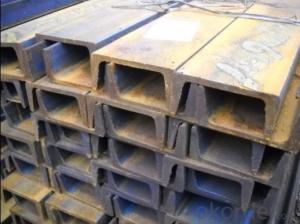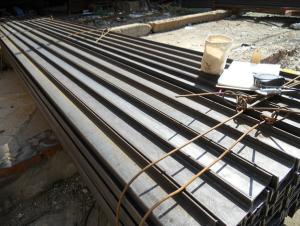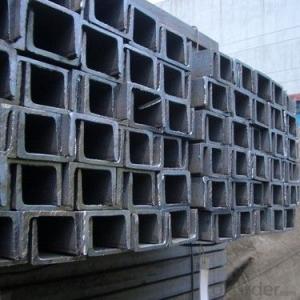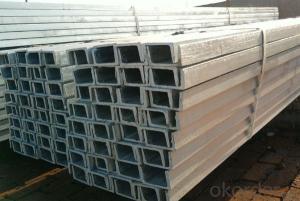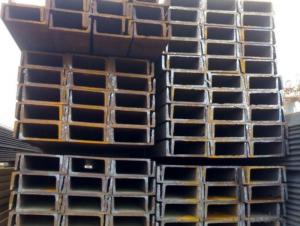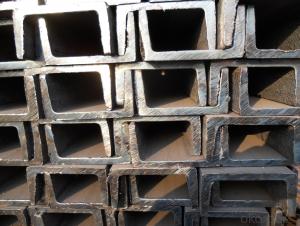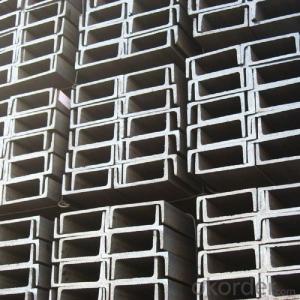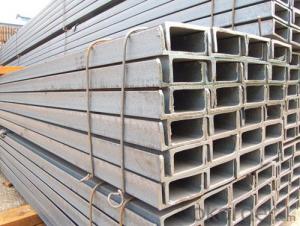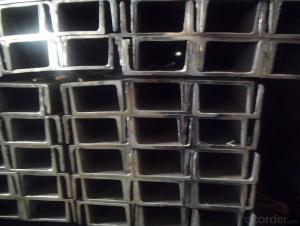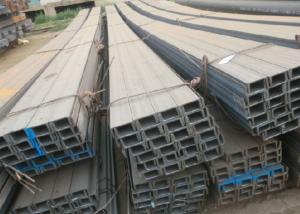100mm EN Standard U Channels for construction
- Loading Port:
- Tianjin
- Payment Terms:
- TT OR LC
- Min Order Qty:
- 25 m.t.
- Supply Capability:
- 10000 m.t./month
OKorder Service Pledge
OKorder Financial Service
You Might Also Like
Usage/Applications of Channel Steel:
Channel Steel is usually used for building structure, vehicle manufacturing and other industrial structure and often used with i beam.
In details, the channel steel belongs to carbon structural steel which is applied to in the field of construction and machinery. The channel steel is usually used for arch-itechtural structure, and they could be welded in order to support or hang a vari-ety of facilities. They are also usually used in combination with I beam. Generally,the channel steel must possess perfect welding property, riveting property and mechanical property and so on.
Package & Delivery of Channel Steel:
The steel u channel will be packed in bundle with steel wire at each end of every bundle and color marking in order to help the customer to recognize his goods more easily at sight.
And steel u channel could be loaded into 20ft or 40ft container, or by bulk cargo. If the weight of each bundle reaches less than 3.5 mt, the loading by break bulk cargo should be choosed. When the weight of each bundle reaches less than 3mt, the loading by container should be choosed.
As for the transportaion from mill to loading port, the truck will be usually used. And the maximum quantity for each truck is 40mt.
Ceiling channel and drywall channel, made of high-quality Snowflakes Steel, adopting laminose strut channel by Cold-formed Technology, are a kind of metal framework made after several continuous rolling. Ceiling keel and wall channel has light-weight, high-intensity, good-antisepsis and other advantages. They mainly match to paperbacked plasterboard and other goods, also the other plates such as GRC, FT and so on.
Product Applications:
purlin and wall beam of steel structure building
Product Advantages:
1.Light,good strength,cauterization resistance and water resistance
2.Matching magnesium fire-proof board,gypsum board and many other wall and ceiling board
3.Moisure-proof ,shock-resistant,high-effcient and environmentally-friendly
4.Easy and fast for installation,time-saving
5. Prompt delivery, high quality ,competitive price and complete sets of styles
6.We can supply you the products based on your specific requirements
Main Product Features:
1). Commponents: main tee, long cross tee, short cross tee and wall angle.
2). Unique click design for easy connection.
3). Widely usage for the suspension system of hotel, school, hospital, shopping mall, etc.
4). Nice outlook with competitive price and good quality.
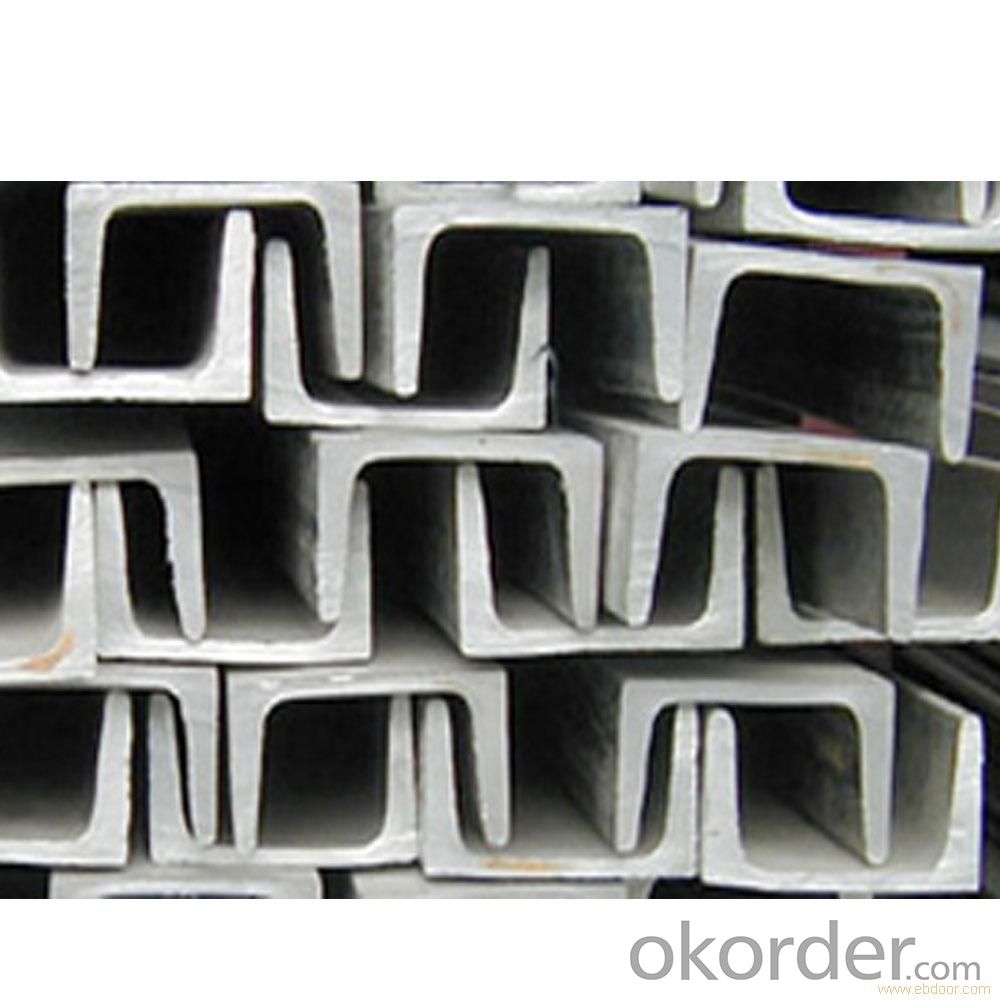
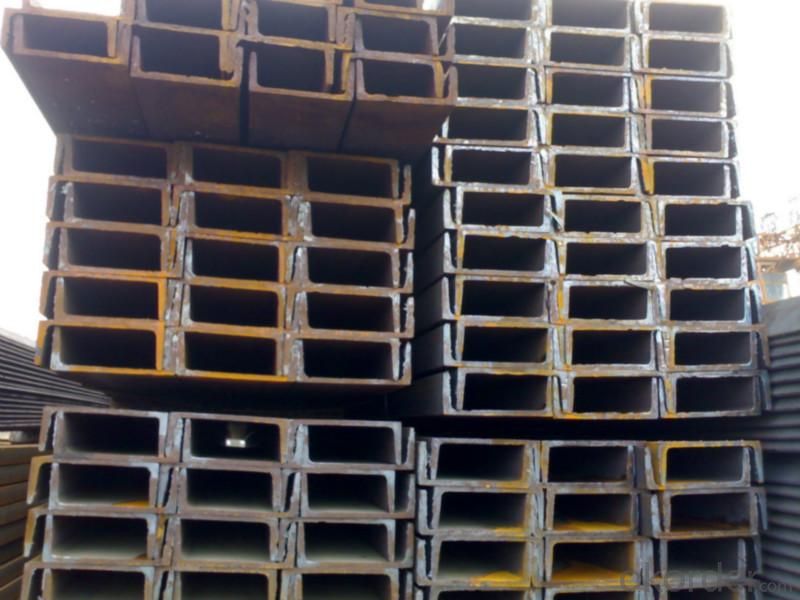
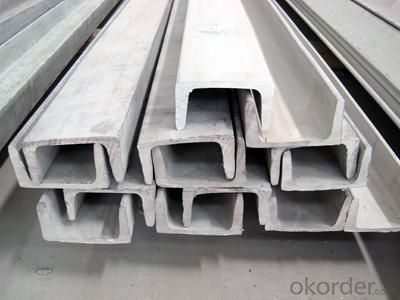
- Q: Can steel channels be used for access ladders?
- Yes, steel channels can be used for access ladders. Steel channels are often used in the construction industry for their high strength and durability. They can be easily welded or bolted together to create a sturdy ladder structure. Steel channels also provide stability and support, making them suitable for use as access ladders. Additionally, their corrosion resistance properties make them suitable for outdoor or industrial environments where exposure to moisture or chemicals may occur. However, it is important to ensure that the steel channels used for access ladders meet the necessary safety standards and regulations to ensure the safety of users.
- Q: What is the use of angle steel and channel steel?
- Angle steel, channel steel is used for shelf purposes
- Q: Are steel channels suitable for use in agricultural applications?
- Yes, steel channels are suitable for use in agricultural applications. They are highly durable, strong, and resistant to environmental factors such as weather and pests. Steel channels can be used for various purposes in agriculture, including constructing animal enclosures, framing structures, and supporting equipment. Their versatility and reliability make them a popular choice in the agricultural industry.
- Q: What are the different applications of steel channels in the automotive industry?
- Steel channels are widely used in the automotive industry due to their various applications and benefits. Here are some of the different applications of steel channels in the automotive industry: 1. Structural Support: Steel channels are commonly used for structural support in automobile frames, chassis, and body panels. They provide strength and rigidity to support the weight of the vehicle and absorb impact forces during collisions. 2. Reinforcement: Steel channels are used to reinforce critical areas of the vehicle, such as door frames, pillars, and roof rails. They enhance the structural integrity and safety of the vehicle, especially in the event of a crash. 3. Suspension Components: Steel channels are utilized in the manufacturing of suspension components like control arms, sway bars, and trailing arms. These components provide stability, control, and smooth ride quality by connecting the wheels to the chassis. 4. Bumper Reinforcements: Steel channels are incorporated into the design of bumper reinforcements to enhance impact resistance and protect both the vehicle and occupants in case of a collision. They distribute and absorb energy during an impact, minimizing damage. 5. Exhaust Systems: Steel channels are utilized in exhaust systems to create the necessary channeling for the exhaust gases to exit the vehicle. These channels are designed to withstand heat, vibrations, and corrosion caused by the exhaust gases. 6. Seat Frames: Steel channels are commonly used in the construction of seat frames, providing strength and durability. They ensure the seats remain secure and stable, offering comfort and safety to the occupants. 7. Roll Cages: Steel channels are employed in the fabrication of roll cages, which are critical safety features in racing vehicles. Roll cages provide protection to the driver in the event of a rollover or crash, preventing the roof from collapsing. In summary, steel channels play a crucial role in the automotive industry, contributing to the strength, safety, and performance of vehicles. Their applications range from structural support and reinforcement to suspension components, bumper reinforcements, exhaust systems, seat frames, and roll cages.
- Q: How do steel channels contribute to the overall strength of a building?
- Steel channels contribute to the overall strength of a building by providing structural support and reinforcement. They are commonly used in construction to transfer loads and distribute weight evenly across different parts of the structure. Steel channels help to prevent sagging, bending, and collapse by increasing the stability and rigidity of the building. Additionally, they enhance the building's resistance to lateral forces such as wind or earthquakes, making it more durable and structurally sound.
- Q: How do steel channels contribute to the overall cost-effectiveness of a wastewater treatment plant?
- There are numerous ways in which steel channels enhance the cost-effectiveness of a wastewater treatment plant. To begin with, steel channels possess exceptional durability and a long lifespan. Consequently, they necessitate minimal maintenance and replacement, resulting in reduced operating costs. By minimizing the need for regular repairs or replacements, the overall maintenance expenses of the plant are lowered. Moreover, steel channels provide outstanding structural strength and stability. They can endure heavy loads and pressures, thereby ensuring the integrity of the wastewater treatment system. This eliminates the requirement for additional reinforcements or supports, lowering construction costs and simplifying the overall design of the plant. Additionally, steel channels offer a high degree of design and installation flexibility. They can be easily customized to meet specific project requirements, enabling efficient utilization of space and resources. This adaptability aids in optimizing the layout of the treatment plant, maximizing its operational efficiency, and reducing construction costs. Furthermore, steel channels exhibit resistance to corrosion and chemical degradation, which is imperative in a wastewater treatment environment. This resistance diminishes the need for frequent replacement or repairs due to corrosion-related issues, resulting in long-term cost savings. Lastly, steel channels are often manufactured using recycled materials, rendering them an environmentally friendly option. By employing recycled steel, the overall production costs are reduced, leading to lower material expenses for the wastewater treatment plant. This not only contributes to the cost-effectiveness of the plant but also promotes sustainability and reduces the carbon footprint associated with its construction. In conclusion, the durability, structural strength, flexibility, corrosion resistance, and use of recycled materials of steel channels all contribute to the overall cost-effectiveness of a wastewater treatment plant. These factors aid in minimizing maintenance and replacement costs, optimizing design and construction, maximizing operational efficiency, and promoting environmental sustainability.
- Q: 16A channel steel size requirements are national standards Oh!
- The national standard for channel steels is "hot rolled steel" GB/T706-2008
- Q: What are the maximum lengths available for steel channels?
- The maximum lengths available for steel channels vary depending on the manufacturer and the specific requirements of the project. However, standard lengths for steel channels typically range from 20 to 40 feet.
- Q: How do steel channels contribute to rainwater harvesting in construction?
- Steel channels are used in rainwater harvesting systems in construction to collect and direct rainwater towards storage tanks or underground reservoirs. These channels are designed to efficiently guide rainwater from rooftops and other surfaces into the collection system, ensuring maximum water capture. They help prevent water loss and erosion by providing a smooth and durable pathway for rainwater to flow, ultimately increasing the effectiveness of rainwater harvesting in construction projects.
- Q: What are the different corrosion protection methods for steel channels?
- To enhance the durability of steel channels and prevent corrosion, several corrosion protection methods can be employed. These methods can be broadly classified into surface treatments, coatings, and cathodic protection. Surface treatments involve various techniques that modify the steel channel's surface to make it more resistant to corrosion. One commonly used method is mechanical cleaning, which entails removing dirt, rust, or mill scale using abrasive techniques like sandblasting or wire brushing. Chemical treatments, such as acid pickling, can also be employed to eliminate impurities and create a clean surface. Coatings are another effective method for protecting steel channels against corrosion. These coatings act as a barrier, preventing corrosive substances from coming into contact with the steel surface. Common coating options include paint, epoxy, zinc, or galvanization. Paints and epoxy coatings provide a protective layer, while zinc or galvanization create a sacrificial layer that corrodes instead of the steel channel. Cathodic protection is a technique that safeguards steel channels by utilizing them as the cathode of an electrochemical cell. This method involves installing sacrificial anodes or impressed current systems. Sacrificial anodes, typically made of metals like zinc or magnesium, are connected to the steel channel and corrode instead of the steel, effectively protecting it from corrosion. Impressed current systems, on the other hand, use an external power source to direct a small current onto the steel channel, preventing corrosion. It is important to consider various factors, such as the environment, application, and budget, when selecting a corrosion protection method. Seeking advice from corrosion experts or engineers can assist in determining the most suitable protection method for specific steel channel requirements.
Send your message to us
100mm EN Standard U Channels for construction
- Loading Port:
- Tianjin
- Payment Terms:
- TT OR LC
- Min Order Qty:
- 25 m.t.
- Supply Capability:
- 10000 m.t./month
OKorder Service Pledge
OKorder Financial Service
Similar products
Hot products
Hot Searches
Related keywords
